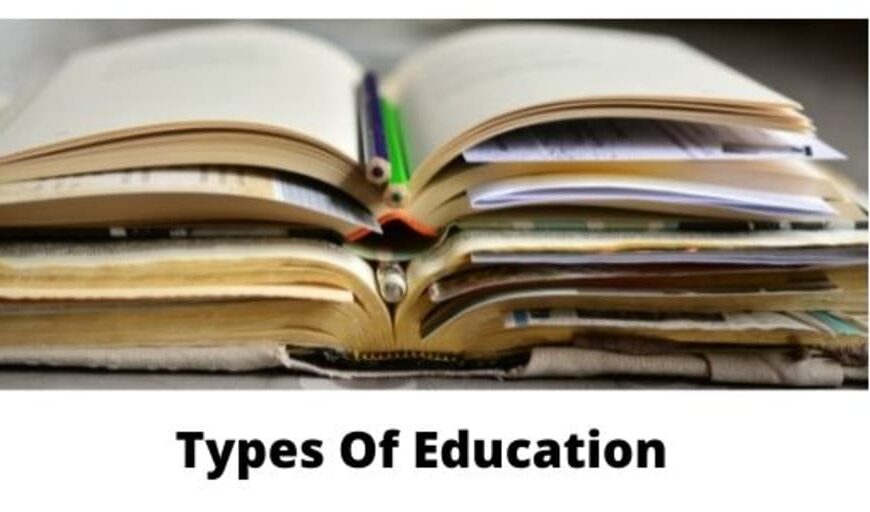What are the 3 Types of Education has always been an important part of our lives, as it is a means for individuals to acquire knowledge and skills. As technology progresses and new methods of teaching become available, the types of education have become more varied. In this article, we will discuss the three main types of education: formal, informal, and non-formal education. We will explain the differences between them and the advantages and disadvantages that come with each type.
What is Education?
The three types of education are formal, non-formal, and informal. Formal education is typically provided by an institution such as a school or university and follows a structured curriculum with set learning outcomes. This type of education usually results in diplomas or degrees.
Non-formal education refers to any organized educational activity outside the formal system, such as vocational training programs or community-based literacy classes. It may not lead to certification but provides practical skills relevant to employment opportunities.
Informal education occurs through life experiences such as self-directed learning or learning from family and peers. It does not follow a specific curriculum, but rather it is acquired through everyday activities that help individuals develop knowledge, skills, attitudes, and values necessary for personal growth and socialization. All three types of education play vital roles in shaping individuals’ knowledge base and skillset for success in their personal lives as well as professional careers.
Type 1: Traditional Education
Type 1: Traditional Education is the most common form of education worldwide. It involves attending a physical classroom with a teacher or lecturer who delivers lessons to students. This type of education follows a strict curriculum, and students are expected to attend classes regularly and complete assignments and exams to progress through the course.
Traditional education has been around for centuries, and it remains popular because it provides students with structure, discipline, and routine. It also offers opportunities for social interaction with teachers and peers in a face-to-face setting, which can be beneficial for some learners. However, traditional education can be rigid and inflexible, often failing to accommodate individual learning styles or cater to diverse backgrounds.
In recent years there has been an increase in blended learning programs that combine traditional classroom instruction with online resources such as video lectures, interactive quizzes etc., providing more flexibility in terms of time management while still preserving aspects of traditional classrooms like teacher-student interactions.
Type 2: Online Education
Type 2: Online Education. Online education has become increasingly popular in recent years due to its convenience and flexibility. It allows individuals to learn from anywhere at any time, making it ideal for those who have busy schedules or cannot attend traditional on-campus classes. Online education programs are offered by universities, colleges, and other educational institutions with a wide range of courses available.
Online education also offers various benefits such as cost savings since students do not need to commute or pay for room and board. Additionally, online programs enable students to interact with instructors and peers through digital platforms such as video conferencing, virtual classrooms, discussion forums, and email. This provides an opportunity for students to connect with people from different parts of the world while developing their communication skills.
However, online education also comes with challenges such as self-discipline since students must independently manage their study schedule and workload without the physical presence of an instructor or classmates. Furthermore, online courses may require a reliable internet connection and access to appropriate technology such as computers or tablets. Despite these challenges, many individuals find online education beneficial in achieving their academic goals while balancing work or personal commitments.
Type 3: Home-schooling
Type 3 of Education is Home-schooling. As the name suggests, home-schooling means educating children at home with the help of parents or guardians rather than sending them to traditional schools. In this type of education, parents or guardians take on the role of teachers and provide their child with tailored educational experiences based on their individual needs and interests.
Home-schooling has grown in popularity over the years, especially since it allows families to have more control over their child’s education. Parents can choose how they want to teach certain subjects and what values they want to instill in their children. It also provides a chance for kids who struggle in traditional classroom settings to receive a more personalized education that caters specifically to their learning style.
However, one drawback of home-schooling is that it may limit socialization opportunities for students as compared to attending traditional schools where they interact with peers from different backgrounds. Nevertheless, home-schooling remains a viable option for many families who seek alternative modes of education.
Pros and Cons of Each
The three types of education are public, private, and homeschooling. Each type has its own set of pros and cons that parents need to consider before making a decision. Public schools are funded by the government, meaning they offer free education. They also have more resources and extracurricular activities than private or homeschooling options. However, public schools often have larger class sizes which can lead to less personalized attention for students.
Private schools offer smaller class sizes and more individualized attention for students. They often have specialized programs or curriculums that focus on certain subjects or interests. However, private schools can be costly and may not be accessible to all families. Additionally, some private schools may lack diversity in terms of socioeconomic status, race/ethnicity, or other factors.
Homeschooling allows for complete flexibility in terms of curriculum and schedule which can benefit some families with unique needs or circumstances such as travel or special needs children. Parents are also able to tailor instruction to fit their child’s learning style and pace. However, homeschooling requires a significant amount of time commitment from parents who must act as both teacher and caregiver while juggling other responsibilities such as work or household duties. Homeschooled children may also miss out on socialization opportunities with peers their age unless they participate in outside activities or groups.
Comparison of Types
There are three types of education: formal, informal, and non-formal. Formal education refers to structured schooling that takes place in a classroom setting. This type of education is usually provided by institutions such as schools or universities and follows a set curriculum designed to meet specific learning outcomes. Formal education is often mandatory and leads to recognized qualifications.
Informal education, on the other hand, is more flexible and takes place outside the traditional classroom setting. This type of education includes learning from experiences that occur naturally as one goes through life, such as learning how to cook or fix a car. Informal education can also be gained through reading books, attending workshops or seminars or watching educational videos.
Non-formal education refers to any organized educational activity that does not follow the traditional school system’s structure but still aims at providing knowledge and skills for personal development. Examples include vocational training programs or adult literacy classes offered outside typical school hours.
In conclusion, while all three types of education play an important role in shaping an individual’s intellectual capacity and skillset, each has its unique characteristics that make it suitable for different purposes depending on what you plan to achieve with your study.
Conclusion
Overall, there are three main types of education that one can pursue throughout their lifetime. These include formal education, non-formal education, and informal education. Formal education is the type of learning that takes place in a structured environment such as schools or universities. This type of education usually leads to a degree or certification and prepares individuals for specific careers.
Non-formal education refers to any type of learning that occurs outside of formal institutions but still has structure and purpose. Examples include vocational programs or training workshops offered by community organizations. These types of programs may not lead to a degree but can still provide valuable skills and knowledge.
Finally, informal education refers to any type of learning that occurs through everyday life experiences such as reading books, watching documentaries or attending cultural events. Although it is often overlooked, informal education plays an important role in shaping our perspectives and worldview.
In conclusion, each type of education offers unique benefits and opportunities for growth depending on the individual’s goals and interests. Whether pursuing a degree at a university or simply reading books on new topics for personal enrichment, it is important to recognize the value and importance of all forms of education throughout our lives.















